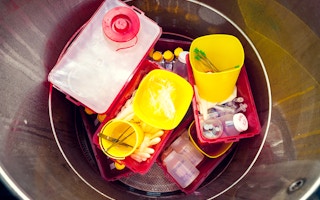Although China has regulations on disposal of medical waste, the danger of pollution from such waste remains very real, experts said.
In 2003, the central government regulated the administration of medical waste, requiring county level governments to build disposal centers where all biohazardous material is treated.
Despite regulations, problems continue to crop up. Dangers of pollution still loom, said Luo Jiefeng, deputy director of the health bureau’s office of medical affairs in Guangxi Zhuang Autonomous Region. “While the law requires all medical scrap to be treated collectively, many hospitals and clinics are not abiding by law due to poor management and substandard facilities,” Luo said.
Medical waste can carry transmittable disease and chemical risk for those who come into contact with it. Plastic in the waste can cause “white pollution,” said Yang Li, deputy director of nursing at the First Affiliated Hospital of Guangxi Medical University.
In 2002, total production of medical waste stood at about 650,000 tons, averaging 1,780 tons per day. The figure has increased by 10 percent every year since then, and now stands at roughly three times that amount.
It consists of disposable items including sharps, human tissue and organs, bodies of animals used in experiments, dressings, patients’ body fluids including blood, etc, said Huang Zhiyong, vice principal of Guangxi Academy of Social Sciences.
In 2011, the municipal government of Guangxi’s Qinzhou City, home to over 300 rural hospitals and clinics, invested more than 18 million yuan (about US$3 million) in building a disposal center 13 kilometers from the city, but it did not help much.
“We send trucks all over to make collections every day, but many hospitals and clinics are far from arterial roads,” said Pan Ling of the center’s operating company. The company can only make collections from 118 medical outlets, leaving more than 200 to basically clean up their own mess. “The center can deal with about 5 tons a day, but we are only processing three,” Pan said.
Way off the beaten track, the problematic material is simply burnt using diesel oil without any decontamination, said Xie Xiuchuang from the health bureau of Lingshan County, Qinzhou. “This is bound to cause air and water pollution, and things like glass bottles are never completely destroyed,” he said.
Another issue is poor management of disposal centers. Regulations state that the material should be disposed of within 24 hours. But earlier this year, residents of Chongkou Village in Guilin City discovered that waste was lying in the open air for months without any treatment at a disposable center, leading to protests.

















